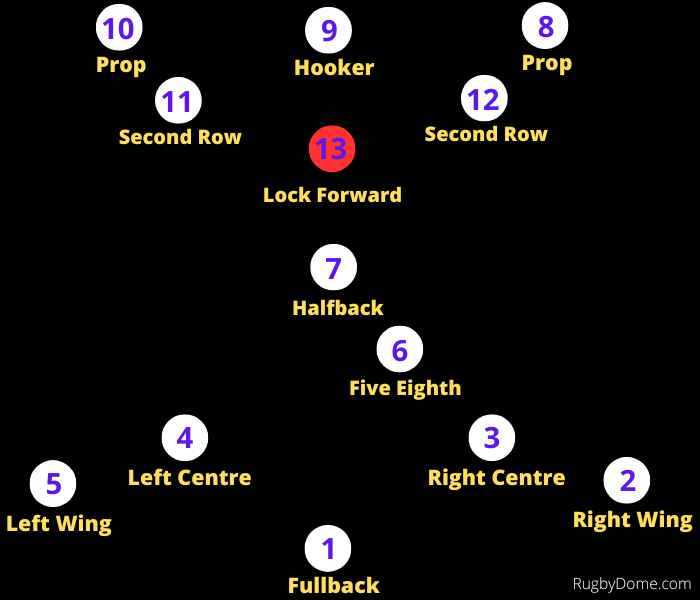The lock forward is also known as the loose forward in rugby league. There is one lock forward on a league team.
They traditionally wear the number thirteen jersey. This article looks at the crucial role of rugby league lock forwards in attack and defence.
Positioning
The position gets its name from the player’s historical role in the scrum.
In the early decades of the sport, scrums were contested. In other words, each team would try to push the opposition off the ball.
Lock forwards would interlock their arms around the legs of the front row (the props and hooker) and “lock” the scrum together. That is why they were called lock forwards.
Nowadays, scrums aren’t contested in league, but the name has stuck. This picture shows the position in the scrum:

Why Are Lock Forwards Also Known As Loose Forwards?
The name “loose forward” is more accurate for the modern role of the position. They are expected to roam around the field and provide the link between forwards and backs.
In other words, they play a more “loose” role than other players in the pack.
What Do Lock Forwards Do In Attack?
Lock forwards are expected to have a wider skill set than other forwards. They must combine the strength and power of a forward with the agility and ball-handling skills of a back.
They get more involved in distributing the ball in attack when the attacking team wants the ball to go wide to the wings. That means they must have excellent passing skills off both hands.
They must be strong support players by reading the game and running off the shoulder of ball carriers. When they receive the ball, they offer the triple threat:
- make a long pass to a centre or winger.
- carry the ball hard into contact.
- get the ball away through offloading in the tackle.
Skillful lock forwards can draw so much attention from the defensive line that they make opportunities and gaps for the backs.
Role Of Lock Forwards In Defence
Loose forwards are usually the fastest forwards on the field. Because of this speed, they are expected to cover the field and make tackles on opposition backs running at full pace.
Pulling off tackles on fast-running backs requires great positional awareness and technique.
Because of their role as the link between forwards and backs, loose forwards typically take a leadership role in organizing the defensive line.
They are often heard urging their teammates to get good line speed i.e. move up aggressively to cut off the attacker’s options.
They are also expected to contest for possession in loose play. If the ball spills away from the tackle area, the loose forward will be trying to snaffle it. They also chase hard after long kicks.
Famous Lock Forwards In League History (Number 8)
Here are two famous lock forwards from two different countries.
Johnny Raper
Johnny Raper grew up in New South Wales, Australia, as one of nine brothers. It’s no wonder he was as tough as nails! He started playing as a second row but switched to lock forward in 1958.
He earned his reputation through the 1960s as one of the great lock forwards in the sport. His combination of ball skills and cover defense was simply better than anybody else.
The player known as “Chook” captained Australia eight times and won thirty-three caps.
Ellery Hanley
Ellery Hanley grew up in Leeds in England. He started his league career in the back line and was so versatile that he could play stand-off or loose forward.
His era was the 1980s when he dominated matches and was frequently the top scorer. He was a key player in several title wins for Wigan.
He also led the 1988 Great Britain Lions tour to their first win against Australia in a full decade.